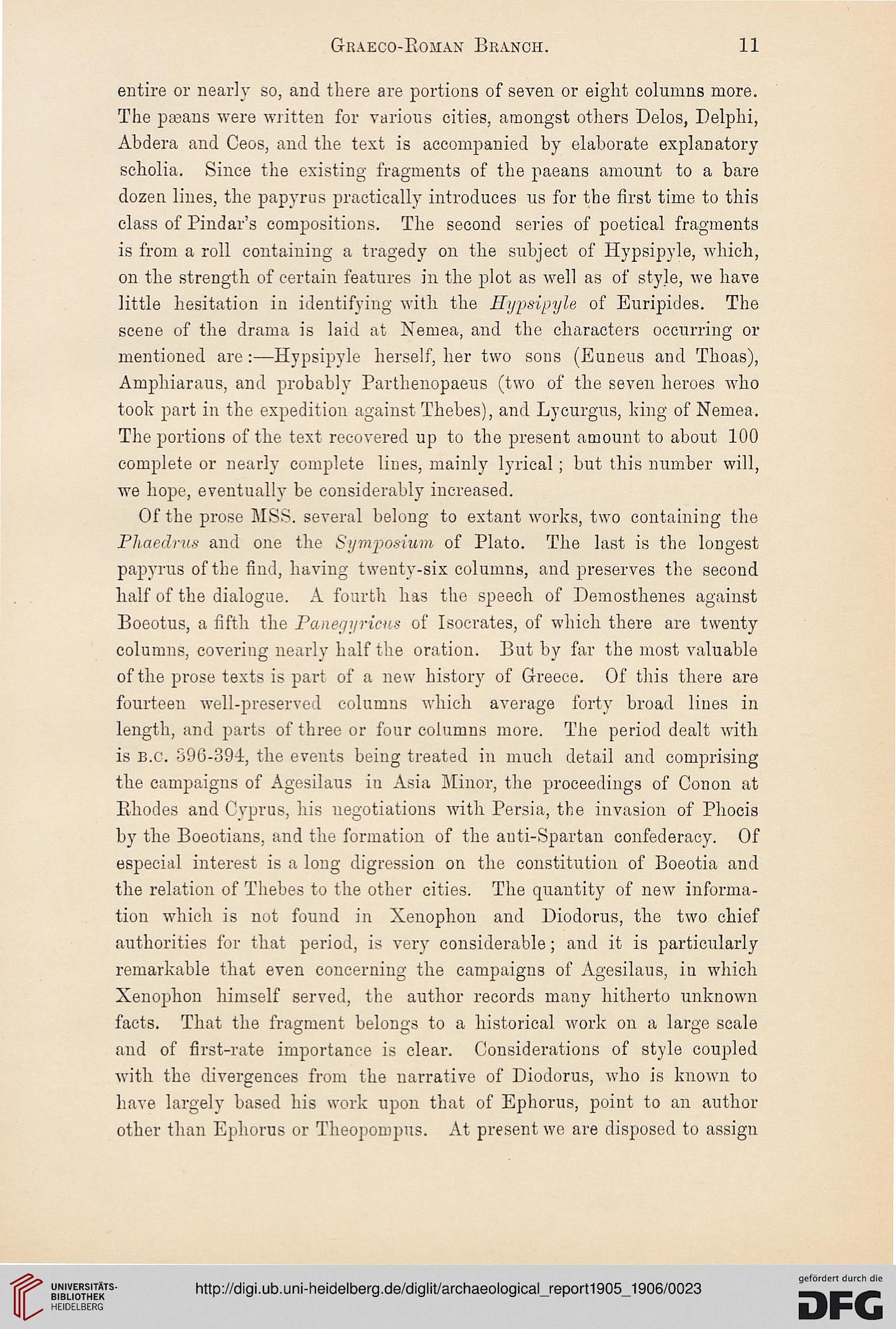Graeco-Roman Branch.
11
entire or nearly so, and there are portions of seven or eight columns more.
The pa;ans were written for various cities, amongst others Delos, Delphi,
Abdera and Ceos, and the text is accompanied by elaborate explanatory
scholia. Since the existing fragments of the paeans amount to a bare
dozen lines, the papyrus practically introduces us for the first time to this
class of Pindar's compositions. The second series of poetical fragments
is from a roll containing a tragedy on the subject of Hypsipyle, which,
on the strength of certain features in the plot as well as of style, we have
little hesitation in identifying with the Hypsipyle of Euripides. The
scene of the drama is laid at Nemea, and the characters occurring or
mentioned are:—Hypsipyle herself, her two sous (Euneus and Thoas),
Amphiaraus, and probably Parthenopaeus (two of the seven heroes who
took part in the expedition against Thebes), and Lycurgus, king of Nemea.
The portions of the text recovered up to the present amount to about 100
complete or nearly complete lines, mainly lyrical; but this number will,
we hope, eventually be considerably increased.
Of the prose MSS. several belong to extant works, two containing the
Phaedrus and one the Symposium of Plato. The last is the longest
papyrus of the find, having twenty-six columns, and preserves the second
half of the dialogue. A fourth has the speech of Demosthenes against
Boeotus, a fifth the Paneyi/riais of Isocrates, of which there are twenty
columns, covering nearly half the oration. But by far the most valuable
of the prose texts is part of a new history of Greece. Of this there are
fourteen well-preserved columns which average forty broad lines in
length, and parts of three or four columns more. The period dealt with
is B.C. S96-394, the events being treated in much detail and comprising
the campaigns of Agesilaus in Asia Minor, the proceedings of Conon at
Rhodes and Cyprus, his negotiations with Persia, the invasion of Phocis
by the Boeotians, and the formation of the anti-Spartan confederacy. Of
especial interest is a long digression on the constitution of Boeotia and
the relation of Thebes to the other cities. The quantity of new informa-
tion which is not found in Xenophon and Diodorus, the two chief
authorities for that period, is very considerable; and it is particularly
remarkable that even concerning the campaigns of Agesilaus, in which
Xenophon himself served, the author records many hitherto unknown
facts. That the fragment belongs to a historical work on a large scale
and of first-rate importance is clear. Considerations of style coupled
with the divergences from the narrative of Diodorus, who is known to
have largely based his work upon that of Ephorus, point to an author
other than Ephorus or Theopompus. At present we are disposed to assign
11
entire or nearly so, and there are portions of seven or eight columns more.
The pa;ans were written for various cities, amongst others Delos, Delphi,
Abdera and Ceos, and the text is accompanied by elaborate explanatory
scholia. Since the existing fragments of the paeans amount to a bare
dozen lines, the papyrus practically introduces us for the first time to this
class of Pindar's compositions. The second series of poetical fragments
is from a roll containing a tragedy on the subject of Hypsipyle, which,
on the strength of certain features in the plot as well as of style, we have
little hesitation in identifying with the Hypsipyle of Euripides. The
scene of the drama is laid at Nemea, and the characters occurring or
mentioned are:—Hypsipyle herself, her two sous (Euneus and Thoas),
Amphiaraus, and probably Parthenopaeus (two of the seven heroes who
took part in the expedition against Thebes), and Lycurgus, king of Nemea.
The portions of the text recovered up to the present amount to about 100
complete or nearly complete lines, mainly lyrical; but this number will,
we hope, eventually be considerably increased.
Of the prose MSS. several belong to extant works, two containing the
Phaedrus and one the Symposium of Plato. The last is the longest
papyrus of the find, having twenty-six columns, and preserves the second
half of the dialogue. A fourth has the speech of Demosthenes against
Boeotus, a fifth the Paneyi/riais of Isocrates, of which there are twenty
columns, covering nearly half the oration. But by far the most valuable
of the prose texts is part of a new history of Greece. Of this there are
fourteen well-preserved columns which average forty broad lines in
length, and parts of three or four columns more. The period dealt with
is B.C. S96-394, the events being treated in much detail and comprising
the campaigns of Agesilaus in Asia Minor, the proceedings of Conon at
Rhodes and Cyprus, his negotiations with Persia, the invasion of Phocis
by the Boeotians, and the formation of the anti-Spartan confederacy. Of
especial interest is a long digression on the constitution of Boeotia and
the relation of Thebes to the other cities. The quantity of new informa-
tion which is not found in Xenophon and Diodorus, the two chief
authorities for that period, is very considerable; and it is particularly
remarkable that even concerning the campaigns of Agesilaus, in which
Xenophon himself served, the author records many hitherto unknown
facts. That the fragment belongs to a historical work on a large scale
and of first-rate importance is clear. Considerations of style coupled
with the divergences from the narrative of Diodorus, who is known to
have largely based his work upon that of Ephorus, point to an author
other than Ephorus or Theopompus. At present we are disposed to assign





